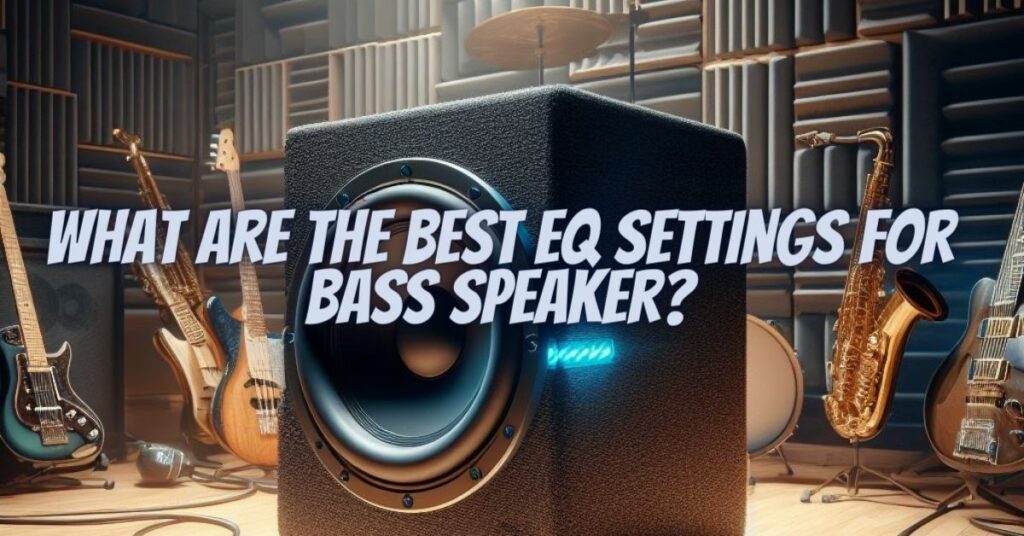Equalization, or EQ, is a powerful tool that allows you to shape and customize the sound of your audio system, including your bass speaker. Finding the best EQ settings for your bass speaker is a journey that can greatly enhance your listening experience, providing you with the perfect balance of depth, punch, and clarity. In this comprehensive guide, we will explore the importance of EQ in audio, the factors to consider when tuning your bass speaker, and tips for achieving the ideal EQ settings.
The Role of EQ in Audio
Equalization is the process of adjusting the balance of frequencies in an audio signal. It involves boosting or cutting specific frequency bands to achieve a desired sound profile. EQ is a crucial tool because it allows you to compensate for room acoustics, optimize audio for different music genres, and tailor the sound to your personal preferences.
Understanding Bass Speaker EQ
Bass speakers, often in the form of subwoofers, handle the lower end of the audio spectrum, focusing on frequencies typically ranging from 20 Hz to 250 Hz. Properly tuning your bass speaker’s EQ is essential because it affects several critical aspects of sound:
- Depth and Impact:
EQ settings can determine how deep and impactful the bass sounds. Adjustments can make the bass notes feel rumbling and powerful or more subtle and controlled.
- Clarity and Detail:
A well-tuned bass speaker enhances the clarity and detail of low-frequency instruments and effects. It ensures that each note is distinct and discernible.
- Room Acoustics:
Room acoustics play a significant role in how bass is perceived. EQ adjustments help compensate for acoustic anomalies in your listening environment, providing a more consistent listening experience.
Factors to Consider When Tuning Bass Speaker EQ
Before diving into the best EQ settings for your bass speaker, consider these factors that can influence your tuning process:
- Room Acoustics:
The size, shape, and furnishings in your room affect how bass frequencies propagate. Be aware of any acoustic challenges and adjust your EQ accordingly.
- Music Genre:
Different music genres have distinct bass characteristics. Consider the type of music you listen to most frequently and tailor your EQ settings to suit those genres.
- Listening Preferences:
Your personal taste in sound plays a vital role. Some people prefer deep and thunderous bass, while others may opt for a more balanced and controlled approach.
- Speaker Specifications:
The capabilities of your bass speaker, including its frequency response and power handling, should guide your EQ adjustments. Refer to the speaker’s documentation for guidance.
Tips for Finding the Best EQ Settings
Now, let’s explore some practical tips to help you discover the best EQ settings for your bass speaker:
- Use a Graphic Equalizer:
A graphic equalizer with sliders for various frequency bands offers a visual representation of your EQ adjustments. This makes it easier to target specific frequencies for tuning.
- Start with a Flat EQ:
Begin with a flat or neutral EQ setting, where all frequency bands are at their default positions. This provides a baseline to work from.
- Listen Actively:
Make adjustments while actively listening to music or content you’re familiar with. Pay attention to how each change affects the bass.
- Focus on Key Frequencies:
The critical frequencies for bass are often in the 40 Hz to 80 Hz range. Focus on these frequencies to find the right balance between depth and clarity.
- Avoid Extreme Boosts or Cuts:
Extremes in EQ settings can lead to distortion or an unnatural sound. Aim for subtle adjustments to maintain a balanced sound.
- Experiment with Different Genres:
Test your EQ settings with a variety of music genres to ensure they work well across different styles.
- Use Test Tracks:
Keep a few reference tracks that you’re familiar with, and use them to fine-tune your EQ settings consistently.
- Consider Room Correction:
Some advanced EQ systems offer room correction capabilities. These systems use microphones to analyze room acoustics and automatically adjust EQ settings for optimal sound.
Finding the best EQ settings for your bass speaker is a rewarding endeavor that can significantly elevate your audio experience. By understanding the role of EQ in audio, considering factors like room acoustics, music genre, and personal preferences, and following the practical tips outlined in this guide, you can fine-tune your bass speaker to deliver a sound that resonates with your unique tastes. Achieving the perfect balance of depth, clarity, and impact ensures that you unlock the full potential of your bass speaker, creating a rich and immersive listening experience that brings your favorite music and movies to life.


